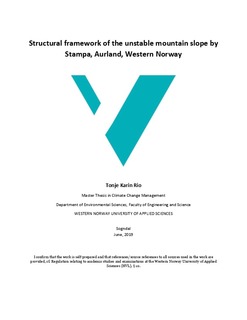| dc.contributor.author | Rio, Tonje Karin | |
| dc.date.accessioned | 2019-09-06T11:54:23Z | |
| dc.date.available | 2019-09-06T11:54:23Z | |
| dc.date.issued | 2019 | |
| dc.identifier.uri | http://hdl.handle.net/11250/2612954 | |
| dc.description | Master Thesis in Climate Change Management Department of Environmental Sciences, Faculty of Engineering and Science | nb_NO |
| dc.description.abstract | Downscaled climate projections point towards a warmer and wetter climate in Norway, which is likely to trigger increased rockslide activity. With many rock slope instabilities and a large record of historical rockslides, Sogn og Fjordane County is especially vulnerable to climate change. The unstable mountain slope by Stampa above Aurlandsfjorden is a structurally complex rock slope instability, which is located predominantly within phyllitic rocks of the Fortun-Vang nappe complex. The aim of this study is (1) to better understand the Caledonian and post-Caledonian deformation history of the area, and (2) to investigate ductile, semi-brittle and brittle structures that may affect the stability of the mountain slope. Fieldwork and associated kinematic, structural and δ18O analyses were conducted. Results indicate that most ductile and semi-brittle structures can be related to top-to-the-NW extensional deformation of the Caledonian collapse. However, some structures can be related to top-to-the-SE contractional deformation of the Caledonian nappe-emplacement. δ18O analyses indicate that various generations of quartz veins were precipitated by locally derived fluids in a lithostatic regime. The abundance and orientation of pre-existing structures seem to have a large control on the overall stability of the mountain slope. Several lithological and structural features are believed to promote rock slope failures at Stampa: (1) Fjord-dipping ductile and semi-brittle structures, (2) folds and interference folds, (3) regional brittle faults and joint sets and (4) lithological discontinuities within the Fortun-Vang nappe complex. The unstable part of the mountain slope can be classified as a cataclinal slope with three active deformation mechanisms. Toppling of unstable blocks occurs on underdip slopes at the edge of the frontal cliff, whereas planar sliding along the foliation occurs on overdip slopes at the toe of the mountain slope. Rotational sliding generally dominates deep-seated gravitational slope deformations (DGSDs) across the full extent of the unstable area(s). Structural mapping of rock slope instabilities and characterisation of active deformation mechanisms may lead to the installation of early warning systems at susceptible sites and thereby decrease the risk of damage on human lives, properties and infrastructure. | nb_NO |
| dc.language.iso | eng | nb_NO |
| dc.publisher | Høgskulen på Vestlandet | |
| dc.rights | Navngivelse 4.0 Internasjonal | * |
| dc.rights.uri | http://creativecommons.org/licenses/by/4.0/deed.no | * |
| dc.subject | Geohazards | nb_NO |
| dc.subject | Climate change | nb_NO |
| dc.subject | Rock slope instabilities | nb_NO |
| dc.subject | Structural mapping | nb_NO |
| dc.subject | ArcGIS | nb_NO |
| dc.subject | Kinematic indicators | nb_NO |
| dc.subject | Failure mechanisms | nb_NO |
| dc.subject | Deep-seated gravitational slope deformations | nb_NO |
| dc.subject | Rockslides | nb_NO |
| dc.subject | Rock falls | nb_NO |
| dc.subject | Rock topples | nb_NO |
| dc.title | Structural framework of the unstable mountain slope by Stampa, Aurland, Western Norway | nb_NO |
| dc.type | Master thesis | nb_NO |
| dc.source.pagenumber | 77 | nb_NO |
| dc.description.localcode | GE4-304 | nb_NO |

